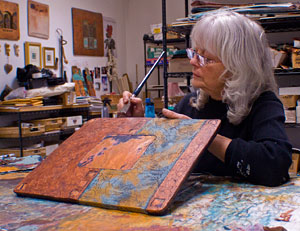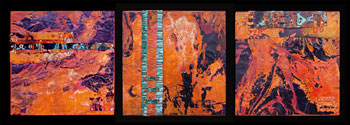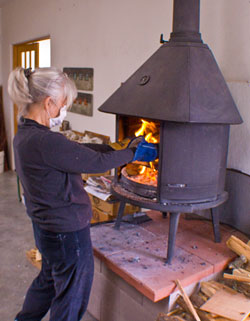The Fired Copper Works of Kara Young
 Jewels M Triptych. Abaca paper with fired copper insets.
Jewels M Triptych. Abaca paper with fired copper insets. Photograph courtesy of Kara Young
Kara Young's copper art is like a phoenix. It rose, literally from the ashes of the biggest urban fire in history.
Young recalls the tragic day when more than 3500 homes burned down in the Oakland firestorm of 1991. As she and her husband dug through the rubble, they cried. But they also gasped at the beauty the fire left behind. They discovered burned rolls of copper that sparked Young with the idea to introduce the metal into her artwork.
"We were crying one minute, and the next, we were like, 'Wow, Look at this cool thing that happened!'" she recalls.
Over the next five years, Young used the burned copper from the fire in different pieces. It became hinges, decorative accents on The Sacred Portal. "I thought of the copper as the gems of each piece," Young told me.
The more she worked with copper, the more she fell in love with its amazing colors and designs.
"Now I burn copper every two-four weeks, fifteen to twenty sheets at a time," she told me. "It's the featured part of my work and the personality of the piece."
Young majored in sculpture at Ohio State University, graduating in 1973. Then she moved to California. In 1986, she began apprenticing under Leo Hobaica, a mixed-media paper artist, before going on to sell her own paper art. Today, she refers to herself as a mixed-media artist, like her mentor.
 Kara Young working in her studio.
Kara Young working in her studio.Photograph courtesy of Kara Young
Young starts each project by making paper. She uses sheets of abaca fiber from the Philippines. In the studio, she pulps it to the consistency of oatmeal. Then she takes a screened wood frame, lays it on a table, puts stretcher bars down, and casts the pulp to the screen.
"I cast it like one might do with clay," Young explains. "Except it's cleaner and wetter"
Depending on how thick Young wants the paper, she forms the pulp to her desired density -- either three quarters of an inch thick or an inch and a half thick. Typically it takes two-five days for the paper to dry. From there, Young trims and gessos the paper, and puts a joint compound on it. The joint compound is typically a handmade black joint pigment, which creates cracks and textures on the surface of the paper.
What happens next in Young's process depends on what she's into doing at the moment. Her work is put out in different series. In each series, copper is featured in a number of ways.
In her Reflections in Copper series, the pieces are made from wood boxes, rather than paper, and are covered in sheets of burned copper. Young's husband helps faux-finish the edges on copper paint, and nails the burned sheets to the boxes. Each box features copper in a different composition. Strips are corrugated, bent, and embellished together in ways that establish the individual personality of each box.
In the Earth and Fire series, Young embeds copper into the joint compound, during the plaster process. She lightly sands the joint compound to give it texture. Then she places copper leafing over the top and bottom, using burned and patinated copper as centerpieces. Some of the works in this series are covered with beeswax, tree resin and pigment, called encaustic. Young slowly melts the beeswax with a heat gun, which causes the pigment to liquefy and feather out, to look like it's floating on top of the paint. The wax is also melted over burned copper, to bring out the colors of the copper. The whole piece is hardened with tree resin on top.
 Copper Reflection Box 3 Set. This process literally arose out of the ashes of the Oakland fire of 1991, where Kara and her husband lost their home.
Copper Reflection Box 3 Set. This process literally arose out of the ashes of the Oakland fire of 1991, where Kara and her husband lost their home.Photograph courtesy of Kara Young
Not all of Young's work requires this process of embedding and waxing. The Jewels from Within series features copper laid in layers in a square. The surface is joint compounded and sanded. A piece of wood sits behind the copper, so it looks like it's floating in the square.
For The Canyon Wall series, Young applies joint compound lightly on top and attaches a single strip of burned and patinated copper across the middle with glue. The bottom half of these pieces are cemented with cracks that are signature to her work. Then she completes the same wax process used in the Earth and Fire series, only without the dry pigment, which causes the paper to look like dry riverbeds.
Another process that helps create this look is copper leafing. For this process, Young attaches copper leaf to the surface of each piece, which results in a textured and cracked appearance. Then, she paints turquoise paint over that and rubs it off, so some remains in the cracks before adding the final layer of burnt umber over the piece, to make it appear aged.
"People think that the pieces are entirely made of copper," Young told me. "I tell them to hold it. They are totally amazed. It looks like it weighs fifty pounds, but it's actually two... which makes it an easier option for hanging."
 Firing copper in a wood stove.
Firing copper in a wood stove.Photograph courtesy of Kara Young
For her patina, Young uses a cold process mix of ammonia, ammonia chloride, lemon juice and vinegar.
"I work with all the elements - earth, air, fire, water," said Young. "I send the copper on its way, putting it into the wood burning stove. It comes out black, I spray it with cold water, and the wonderful colors appear.There are no chemicals in the process. Either it's there for me or it's not. This is my dance with the fire element."
Young draws her inspiration from the environment around her, and refers to nature as "the first teacher."
Nature gives her peace and grounding, and she wants to pass that onto others.
"I'm nature, I am interested in the micro, not the macro," she explains. "I like to photograph canyon walls, dry river beds, and lichen growing on large rocks. These are hard to recreate because they happen over centuries. I like to spend time in one area, observing the small things, not conquering the mountain."
Currently, Young is working on a new series of fine art. She's interested in using copper that she finds---rusted old pieces. Her plan is to return to wood boards again. Over the next several months, she will be traveling to shows in Breckenridge, Colorado and Park City, Utah. She recently returned from a three-week trip, participating in shows in Dallas, Austin, and San Antonio.
Ultimately though, Young's Phoenix has landed in Santa Fe and wants to stay there.
"I'm looking out my window," she said, dreamily. "And seeing mountain ranges and ranch land."
Resources:
Also in this Issue:
- The Fired Copper Works of Kara Young
- When Innovative Processes Combine, The Result Is Breathtaking
- Weaving His Way Through Copper: David Paul Bacharach
- Renee Lammers: Plein Air Copper Painter
- First Look at Antico's Rare Renaissance Sculpture on View at The Frick Collection
